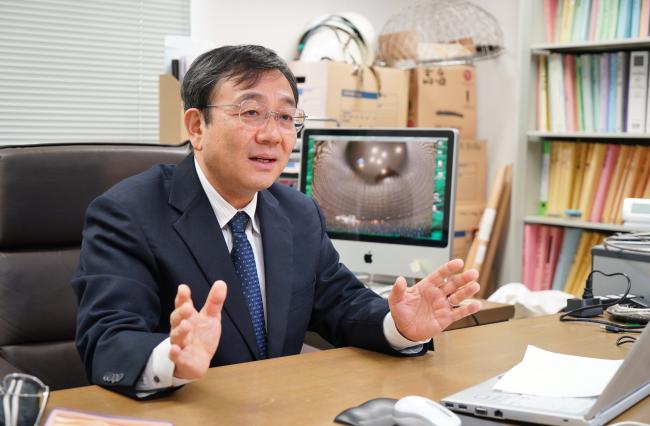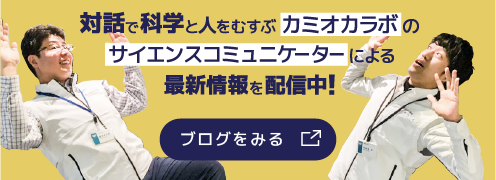Interview with Dr.Nakahata about KamiokaLab
Following the interview with Dr.Kajita, today we will interview Dr. Masayuki Nakahata, who is both the assistant manager at the Institute for Cosmic Ray Research, University of Tokyo and a manager of Kamioka Observatory. The Hida Space Science Museum KamiokaLab will open on March 27, 2019. It showcases astrophysics research mainly from the Super-Kamiokande where Dr. Nakahata is a project manager.
What kind of facility is KamiokaLab?

KamiokaLab mainly shows and explains the Super-Kamiokande facility where we have been studying. The Institute for Cosmic Ray Research, University of Tokyo and Hida City made an agreement to cooperate in January 2017. Even from the early planning stage, we worked carefully with both experts and everyday people to make the Hida Space Science Museum KamiokaLab. We discussed and decided what and how to display with everyone, so I am sure that it will be a facility where everyone can understand our research easily. Probably, many Japanese people have heard about Super-Kamiokande and neutrinos since Dr. Kajita received a Nobel Prize for physics. Even a layman should be able to understand the systems and content of his research at this facility.
What would you like to introduce the most at the Hida Space Science Museum KamiokaLab?

There is a huge screen set up in the middle of the exhibition hall. You can see the mine shaft and experiment area on a recorded video. It is definitely powerful. In 2018, we opened the tank of the Super-Kamikande to upgrade it for the first time in 12 years. You are able to see the opening of the tank on the video. It shows the 11,000 PMTs (Photomultiplier Tubes) which play an important role for Super-Kamikande. We also have a display of PMTs identical to those used in the Super-Kamikande.
Super-Kamikande is also made thanks to the advanced technologies used by local companies: drilling technology by Kamioka Mining and Smelting Co., LTD.; high-sensitivity PMT Photonics by Hamamatsu Photonics K.K.; techniques for constructing stainless steel tanks by Mitsui E&S; and manufacturing extremely pure water by ORGANO Corporation. You can enjoy our exhibition while marveling at the wonderful technologies that support some of the world’s most advanced research.
Please tell us something particular about KamiokaLab.
We are particular about the accuracy of the exhibitions. There is a display of PMTs, which we use in the Super-Kamiokande. All of the fixed parts are the same as those used in the actual Super-Kamiokande! This includes the fittings, like screws or nuts, and the actual PMTs. Unfortunately, the cover of the actual Super-Kamiokande can’t be opened during observation. However, it feels like being inside of the real tank at KamiokaLab.
Who do you want visiting KamiokaLab?
Well, I would like many people of all ages to visit. I especially hope students visit. I hope they will become interested in science and study in the field in the future. Also, anyone who is interested in the mystery of space can enjoy this facility.
What is Super-Kamionde for you?
I feel like it is a part of my body. The neutrinos are the eyes with which I use to see the whole of space. Of course the Super-Kamiokande is much larger than me!
What role do you expect KamiokaLab play in the future?
At present, the Super-Kamiokande is preparing for its next stage. It is called the “Super -Kamiokande Gadolinium Experiment”, or SK-Gd. The sensitivity of the equipment has been improved by adding extremely pure water to a kind of rare earth element, Gadolinium. Because of this, we are able to unravel the histories of stars and planets and the origin of the matter which composes our body. Astronomy continues to progress day by day. I hope KamiokaLab can tell many people about our latest research. We are expecting to start experimentation in the second half of the 2020s using the new Hyper-Kamiokande.
The new Hyper-Kamiokande detector is designed to be 10 times larger than the previous Super-Kamiokande and is equipped with higher sensitivity photo sensors. We are expecting to step into new fields of study. I hope the new Hyper-Kamiokande will be introduced at KamiokaLab someday. There will be an area where researchers and visitors can interact with each other at KamiokaLab as a part of our outreach activities. We hope to tell visitors about our actual research.
Finally, please give a message to the citizens of Hida.

Thanks to the understanding and cooperation of local people, we will be able to continue researching in Kamioka for a long time. Again, I would like to express my gratitude. Through KamiokaLab, I hope you will gain a deeper understanding of our research and share the joy of discovery.
Coverage date
December 27, 2018




